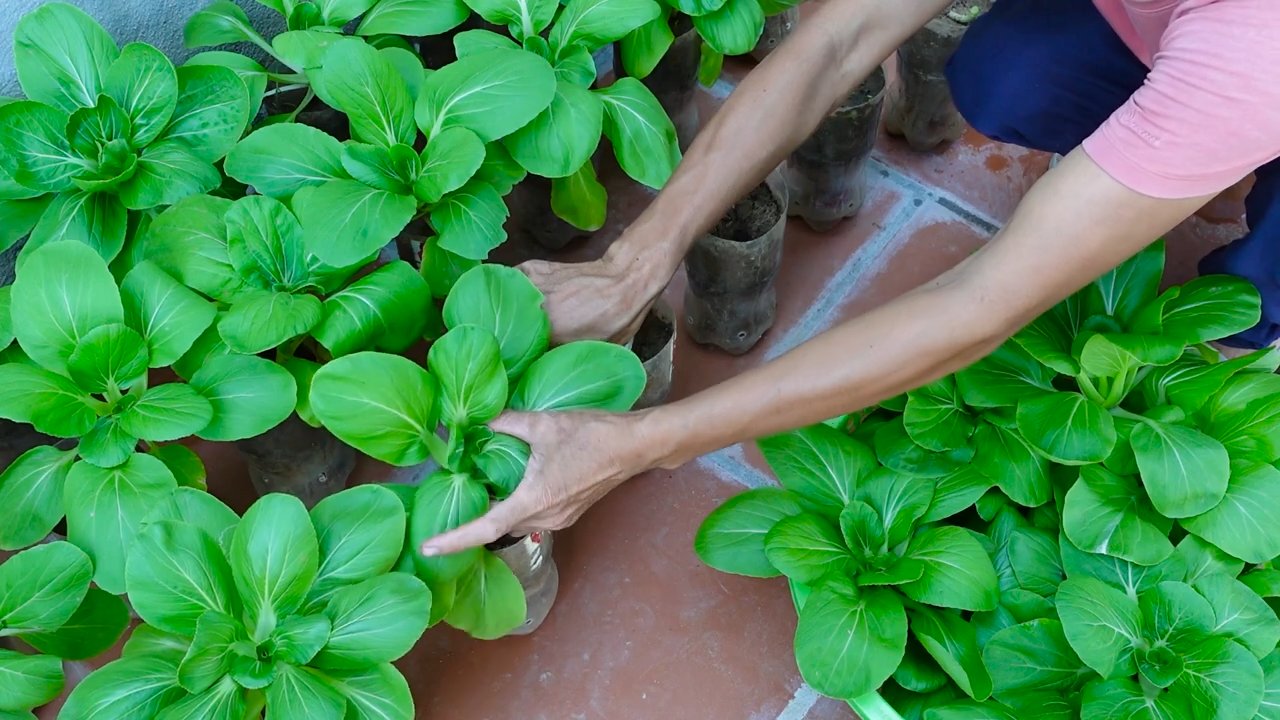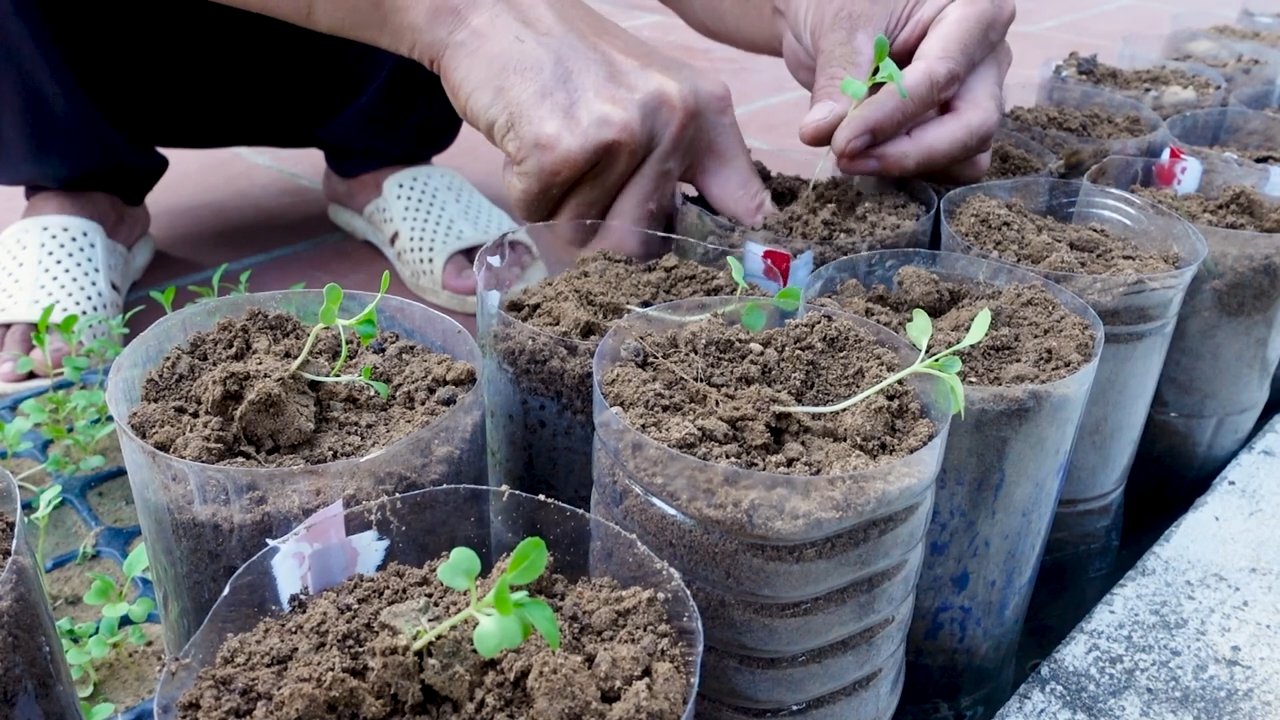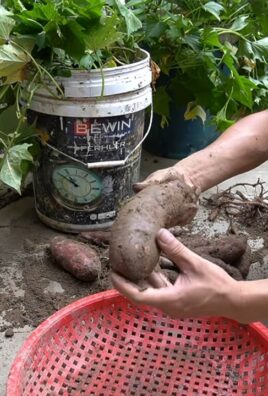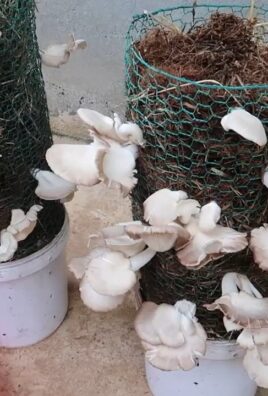Container gardening for small spaces is your ticket to fresh herbs, vibrant flowers, and even delicious vegetables, no matter how limited your outdoor area might be! Ever dreamt of snipping fresh basil for your pasta or enjoying a colorful bloom right outside your window, even if you only have a tiny balcony or patio? Well, dream no more! This article is packed with clever DIY tricks and hacks to transform even the smallest spaces into thriving green havens.
The concept of growing plants in containers actually dates back centuries, with evidence found in ancient Egypt and Rome. These early forms of container gardening allowed people to cultivate plants in portable ways, bringing beauty and sustenance wherever they went. Today, the spirit of adaptability lives on!
Let’s face it, not everyone has a sprawling backyard. But that shouldn’t stop you from enjoying the joys of gardening. That’s where container gardening for small spaces comes in. I’m going to show you how to maximize every inch, choose the right containers and plants, and even create DIY watering systems to make your gardening journey a breeze. Get ready to unleash your inner gardener and create a beautiful, productive oasis, no matter how small your space!

Container Gardening: Grow Your Own Oasis, Even in Tiny Spaces!
Hey there, fellow plant enthusiasts! Living in a small apartment or having a tiny balcony doesn’t mean you can’t enjoy the joys of gardening. I’m here to show you how to create a thriving container garden, maximizing your space and bringing a touch of nature to your urban jungle. Let’s get our hands dirty!
Choosing the Right Containers
The first step to a successful container garden is selecting the right containers. Don’t just grab the first pot you see! Consider these factors:
* Size Matters: Think about the mature size of the plants you want to grow. A tiny succulent won’t need a huge pot, but a tomato plant will. Bigger is generally better, as it allows for more root growth and better water retention.
* Material World: Containers come in various materials like plastic, terracotta, ceramic, wood, and even metal. Each has its pros and cons.
* Plastic: Lightweight, inexpensive, and retains moisture well. Great for beginners!
* Terracotta: Classic look, porous (dries out faster), and can be heavy.
* Ceramic: Beautiful, but can be expensive and heavy.
* Wood: Natural look, but needs to be treated to prevent rotting.
* Metal: Can get very hot in the sun, potentially harming roots.
* Drainage is Key: This is non-negotiable! Every container *must* have drainage holes. Excess water can lead to root rot, which is a plant’s worst enemy.
* Consider Your Style: Choose containers that complement your aesthetic. A mismatched collection can look charming, or you can opt for a cohesive look with similar colors and styles.
* Think Vertically: In small spaces, vertical gardening is your best friend! Hanging baskets, wall planters, and tiered planters can dramatically increase your growing area.
Selecting the Right Soil
Don’t underestimate the importance of good soil! Using garden soil in containers is a big no-no. It’s too heavy and doesn’t drain well. Instead, opt for a:
* Potting Mix: This is a lightweight, well-draining mix specifically formulated for container gardening. It usually contains peat moss, perlite, and vermiculite.
* Soilless Mix: This is even lighter than potting mix and often contains coconut coir instead of peat moss. It’s a great option for plants that need excellent drainage.
* Amendments: Consider adding compost or other organic matter to your potting mix to improve its fertility and water retention.
Choosing the Right Plants
Now for the fun part! Selecting plants that will thrive in your container garden. Consider these factors:
* Sunlight: How much sun does your space get? Choose plants that are suited to the amount of light you have.
* Full Sun (6+ hours): Tomatoes, peppers, herbs like basil and rosemary, sunflowers.
* Part Sun (4-6 hours): Lettuce, spinach, kale, strawberries, herbs like mint and parsley.
* Shade (Less than 4 hours): Hostas, ferns, impatiens, begonias.
* Size: Choose plants that won’t outgrow their containers too quickly. Dwarf varieties are often a good choice for small spaces.
* Compatibility: Some plants grow well together, while others compete for resources. Do some research to make sure your chosen plants are compatible.
* Your Preferences: What do you want to grow? Vegetables, herbs, flowers? Choose plants that you’ll enjoy and use.
* Consider these options for small spaces:
* Herbs: Basil, mint, chives, thyme, rosemary, oregano. These are compact, fragrant, and useful in the kitchen.
* Vegetables: Lettuce, spinach, kale, radishes, bush beans, cherry tomatoes, peppers. Look for dwarf or compact varieties.
* Flowers: Petunias, pansies, impatiens, begonias, marigolds, geraniums. Choose colorful and long-blooming varieties.
* Strawberries: These are perfect for hanging baskets or window boxes.
Planting Your Container Garden: Step-by-Step
Alright, let’s get planting! Here’s a step-by-step guide to creating your container garden:
1. Gather Your Supplies: You’ll need your containers, potting mix, plants, a trowel, a watering can, and gloves (optional).
2. Prepare Your Containers: If your containers are new, give them a good rinse. If they’re used, clean them thoroughly to remove any dirt or debris.
3. Add Drainage Material (Optional): Some people like to add a layer of gravel or broken pottery to the bottom of their containers to improve drainage. This is optional, but it can be helpful in heavy containers. I personally don’t find it necessary if you’re using a good potting mix.
4. Fill with Potting Mix: Fill your containers with potting mix, leaving a few inches of space at the top.
5. Prepare Your Plants: Gently remove your plants from their nursery pots. Loosen the roots slightly by gently teasing them apart. This will encourage them to grow outwards into the new soil.
6. Plant Your Plants: Dig a hole in the potting mix large enough to accommodate the root ball of your plant. Place the plant in the hole and gently backfill with potting mix. Make sure the top of the root ball is level with the surface of the soil.
7. Water Thoroughly: Water your plants thoroughly after planting. This will help settle the soil and encourage root growth.
8. Add Mulch (Optional): Adding a layer of mulch, such as wood chips or straw, to the surface of the soil can help retain moisture and suppress weeds.
9. Label Your Plants: This is especially important if you’re growing multiple varieties of the same plant. You can use plant markers or even popsicle sticks.
10. Find the Perfect Spot: Place your containers in a location that receives the appropriate amount of sunlight for your chosen plants.
Watering and Fertilizing
Proper watering and fertilizing are crucial for a healthy container garden.
* Watering: Container gardens tend to dry out faster than in-ground gardens, so you’ll need to water them more frequently. Check the soil moisture regularly by sticking your finger into the soil. If the top inch or two feels dry, it’s time to water. Water deeply until water drains out of the drainage holes. Avoid overwatering, as this can lead to root rot. The frequency of watering will depend on the weather, the type of plants you’re growing, and the type of container you’re using.
* Fertilizing: Container plants rely on you to provide them with the nutrients they need. Use a balanced fertilizer specifically formulated for container gardening. Follow the instructions on the fertilizer package. You can use a liquid fertilizer or a slow-release fertilizer. Liquid fertilizers need to be applied more frequently, but they provide nutrients quickly. Slow-release fertilizers release nutrients gradually over time. I personally prefer slow-release fertilizers for ease of use.
Maintaining Your Container Garden
A little maintenance goes a long way in keeping your container garden thriving.
* Deadheading: Remove spent flowers to encourage more blooms.
* Pruning: Prune your plants as needed to maintain their shape and size.
* Pest Control: Keep an eye out for pests and diseases. Treat them promptly with organic pest control methods, such as insecticidal soap or neem oil.
* Weeding: Remove any weeds that pop up in your containers.
* Rotating Containers: Rotate your containers regularly to ensure that all sides of the plants receive equal sunlight.
* Repotting: As your plants grow, they may need to be repotted into larger containers. Repotting is usually necessary every year or two.
Vertical Gardening Ideas for Small Spaces
As I mentioned earlier, vertical gardening is a game-changer for small spaces. Here are some ideas to get you started:
* Hanging Baskets: These are perfect for trailing plants like petunias, strawberries, and herbs.
* Wall Planters: Mount planters on your walls or fences to create a living wall.
* Tiered Planters: These planters stack on top of each other, creating a multi-level garden.
* Pallet Gardens: Repurpose a wooden pallet into a vertical garden by attaching planters to the slats.
* Trellises: Use trellises to support climbing plants like tomatoes, cucumbers, and beans.
* DIY Vertical Gardens: Get creative and build your own vertical garden using recycled materials like plastic bottles or tin cans.
Troubleshooting Common Problems
Even with the best care, you may encounter some problems in your container garden. Here are

Conclusion
So, there you have it! Transforming even the tiniest balcony, patio, or windowsill into a thriving green oasis is entirely within your reach. This guide to container gardening for small spaces isn’t just about planting flowers; it’s about creating a personalized, vibrant extension of your living space, a sanctuary where you can connect with nature, even amidst the hustle and bustle of city life.
We’ve explored the essentials, from selecting the right containers and soil to choosing plants that flourish in limited spaces. Remember, the key is to think vertically, utilize every nook and cranny, and choose plants that complement each other in terms of sunlight and watering needs.
But the real magic lies in the experimentation. Don’t be afraid to try different combinations of herbs, vegetables, and flowers. Consider adding trailing plants like cascading petunias or sweet potato vines to soften the edges of your containers and create a more lush, overflowing effect. For a touch of whimsy, incorporate small decorative elements like pebbles, miniature figurines, or even repurposed household items.
Why is this DIY container gardening trick a must-try? Because it empowers you to cultivate beauty and freshness, regardless of your square footage. It’s a sustainable way to grow your own food, a therapeutic activity that reduces stress, and a visually stunning addition to your home. Plus, the satisfaction of harvesting your own tomatoes, snipping fresh herbs for dinner, or simply enjoying the vibrant colors of your flowers is truly unparalleled.
And the possibilities are endless! Consider these variations to personalize your container garden:
* Aromatic Herb Garden: Create a fragrant haven with rosemary, thyme, lavender, and mint. Perfect for culinary enthusiasts and aromatherapy lovers alike.
* Salad Bowl Garden: Grow your own salad greens with lettuce, spinach, arugula, and radishes. A healthy and delicious addition to any meal.
* Pollinator Paradise: Attract bees and butterflies with colorful flowers like zinnias, sunflowers, and butterfly bushes. A beautiful and beneficial addition to your garden.
* Succulent Sanctuary: Create a low-maintenance, drought-tolerant garden with a variety of succulents and cacti. Perfect for busy individuals or those living in arid climates.
We’ve given you the foundation, now it’s time to unleash your creativity and transform your small space into a container gardening paradise. We are confident that you will find the process rewarding and the results stunning.
So, grab your gloves, gather your supplies, and get ready to dig in! We can’t wait to see what you create. Don’t forget to share your container gardening creations with us on social media using #SmallSpaceGardening. We’re eager to see your innovative designs and learn from your experiences. Happy gardening!
Frequently Asked Questions (FAQ)
What are the best types of containers for small space gardening?
Choosing the right containers is crucial for success. Consider these options:
* Hanging Baskets: Ideal for trailing plants and flowers, maximizing vertical space.
* Wall-Mounted Planters: Perfect for balconies and patios, adding greenery without taking up floor space.
* Stackable Planters: Great for growing herbs and vegetables, creating a tiered effect.
* Self-Watering Containers: Helpful for busy gardeners, ensuring consistent moisture levels.
* Repurposed Items: Get creative with old buckets, crates, or even shoes! Just make sure they have drainage holes.
The material of the container also matters. Terracotta pots are porous and allow for good drainage, but they can dry out quickly. Plastic pots retain moisture better but can overheat in direct sunlight. Consider your climate and watering habits when making your selection.
What kind of soil should I use for container gardening?
Avoid using garden soil in containers, as it can become compacted and poorly drained. Instead, opt for a high-quality potting mix specifically designed for container gardening. These mixes are typically lightweight and well-draining, providing the ideal environment for root growth. You can also amend your potting mix with compost or other organic matter to improve its fertility and water retention.
How often should I water my container garden?
Watering frequency depends on several factors, including the type of plants, the size of the container, the weather, and the type of soil. As a general rule, check the soil moisture daily by sticking your finger about an inch into the soil. If it feels dry, it’s time to water. Water deeply until water drains out of the bottom of the container. Avoid overwatering, as this can lead to root rot. During hot, dry weather, you may need to water your containers more frequently.
What are some low-maintenance plants for container gardening?
If you’re looking for plants that require minimal care, consider these options:
* Succulents: Drought-tolerant and easy to grow, succulents come in a wide variety of shapes and colors.
* Herbs: Many herbs, such as rosemary, thyme, and oregano, are relatively low-maintenance and can thrive in containers.
* Geraniums: These classic flowers are known for their vibrant colors and long blooming season.
* Petunias: Another popular choice for container gardening, petunias are easy to grow and come in a wide range of colors.
* Lavender: This fragrant herb is drought-tolerant and attracts pollinators.
How do I fertilize my container garden?
Container plants rely on you to provide them with the nutrients they need to thrive. Fertilize your container garden regularly with a balanced, water-soluble fertilizer. Follow the instructions on the fertilizer package for application rates and frequency. You can also use slow-release fertilizers, which provide nutrients over a longer period of time.
How do I protect my container garden from pests and diseases?
Regularly inspect your plants for signs of pests or diseases. If you spot any problems, take action immediately. Common pests include aphids, spider mites, and whiteflies. You can control these pests with insecticidal soap or neem oil. Diseases can be prevented by providing good air circulation and avoiding overwatering.
Can I grow vegetables in containers?
Absolutely! Many vegetables thrive in containers, including tomatoes, peppers, cucumbers, lettuce, and herbs. Choose dwarf or compact varieties that are well-suited for container gardening. Make sure your containers are large enough to accommodate the root systems of your chosen vegetables.
How do I overwinter my container plants?
Depending on your climate, you may need to overwinter your container plants indoors. Bring tender plants indoors before the first frost. Place them in a bright, sunny location and water them sparingly. Dormant plants can be stored in a cool, dark place.
What if I don’t have a lot of sunlight?
Even if you don’t have a lot of sunlight, you can still grow a container garden. Choose plants that tolerate shade, such as impatiens, begonias, ferns, and hostas. You can also supplement natural light with grow lights.
How can I make my container garden more visually appealing?
There are many ways to enhance the visual appeal of your container garden. Consider these tips:
* Choose a color scheme: Select plants with complementary colors to create a cohesive look.
* Vary the heights and textures: Combine tall, upright plants with trailing plants and plants with different leaf textures.
* Add decorative elements: Incorporate pebbles, shells, or other decorative items to add interest.
* Group containers together: Create a focal point by grouping several containers together.
* Use interesting containers: Choose containers that complement your plants and your overall style.
Remember, container gardening is all about experimentation and creativity. Don’t be afraid to try new things and have fun!




Leave a Comment